Ballast is necessary in ships for stability, balance, trim and to otherwise keep them upright because the alternative is not pleasant. The amount of ballast necessary varies based on the type of ship and the amount of cargo if any. Legend has it that many buildings and roadways in the Colonies were constructed out of brick and cobblestones that came over from Europe as ballast on ships. Alas, it is only a legend, as the vast majority of buildings and roadways were constructed out of native bricks and cobblestones. Not enough ballast came over to make a significant dent in the infrastructure of the time1. But enough came over to end up in a few historic landmarks and provide fodder for the legend. The main reason this type of ballast came over was because more cargo went east to Europe at the time than the other way around. How times have changed, now more comes to America than leaves. Hold that thought for later.
More recently, in this past century, ballast from England was instrumental in the construction of a New York City landmark. During the Second World War the United States provided an Atlantic lifeline to England supplying men and materials for the war effort. Canadians escorted the allied convoy ships and for a time Canada had the third largest navy in world2. Many of the convoy ships disembarked in Bristol, England, a major port city. The ships “had no British goods to replace them on the return trip, and needed ballast for stability.3” The Luftwaffe solved the ballast problem by bombing the city to near devastation. The brick rubble from the Luftwaffe bombing provided the ballast for the empty convoy ships returning to America. In New York City this ballast was used to build East River Drive.
Our story now takes us to North Carolina and a local “good ole boy”. Malcom McLean, armed with a high school education, bought a secondhand truck from savings earned pumping gas and started a trucking company that ended up changing the world4. He wanted a way to move cargo on ships without having to unload his trucks. He figured he could just load his trucks onto ships, strap them down, and be done with it. That didn’t work very well. But this “good ole boy” didn’t’ give up. He needed an engineer to make things work. An old school engineer. My kind of engineer.
Keith Tantlinger, a mechanical engineering graduate from the University of California, Berkeley who worked for the Douglas Aircraft Company during the war building B-17 bombers solved McLean’s problem. Disconnect the truck payload from the truck chassis. Have a bunch of stackable boxes that could go from a truck chassis onto a railroad car or onto a ship. This was not a new idea, but Tantlinger made it work by designing the boxes and the method of securing the boxes and the method of lifting the boxes. He created the “intermodal freight container”. Intermodal because it went from ship to rail to truck without unloading and reloading the contents.5 Today we call it a “shipping container” (Photograph 1).
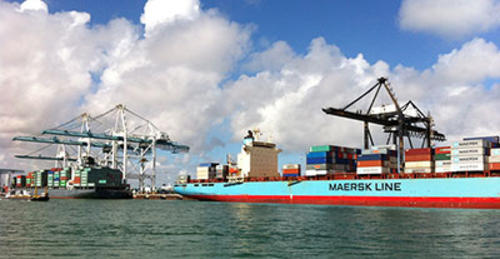
Photograph 1: Intermodal Shipping—Changing the world courtesy of a good ole boy from North Carolina and an old school engineer from the University of California at Berkley.
What was so special about Tantlinger’s box? He created a “twistlock” that was a rotating connector that locked into a corner casting built into the eight corners of the box (“cube”)(Photograph 2). Each box had strong corner posts so that they could be stacked (Photograph 3). The ability to stack the boxes and secure the boxes to a “bed” and also to each other was revolutionary. The “double cone” twistlock became a staple in the shipping and transport industry and “stack and lock” containers dominate to this day. Tantlinger also developed a container spreader bar. A stevedore was no longer necessary to attach ropes to lift and move the containers. This forever endeared Tantlinger to the International Longshoreman’s Association.
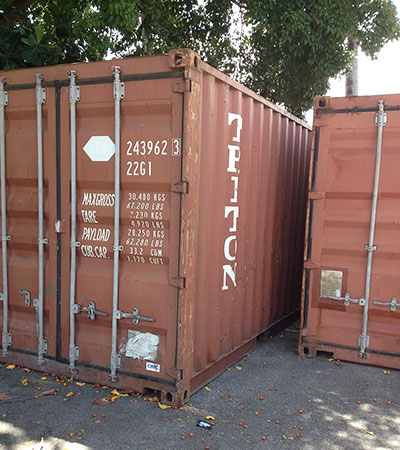
Photograph 2: Tantlinger’s Box—Note the corner castings built into the eight corners of the shipping container. A rotating connector “twistlock” locks into the corner castings. The “double cone” twistlock became a staple in the shipping and transport industry and “stack and lock” containers dominate to this day. The ability to stack the boxes and secure the boxes to a “bed” and also to each other was revolutionary.
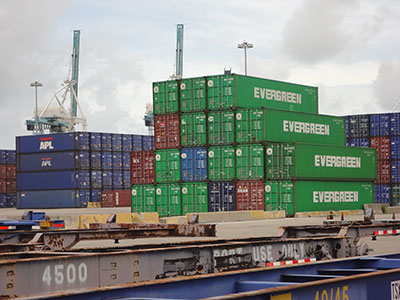
Photograph 3: Stack Effect—A different kind of stack effect for sure. Each box has strong corner posts so that they can be stacked.
So how do shipping containers and ballast tie together? If the ships carrying the shipping containers are sailing with full shipping containers the ships don’t need a lot of ballast. If the ships carrying the shipping containers are sailing with empty shipping containers the ships need a lot of ballast. Duh.
So what kind of ballast is used today? Water. Water is taken from one port and pumped into “ballast tanks” after the ships unload cargo and is discharged at the next port when the ships take on more cargo. This has become a rather significant environmental issue as the water contains a lot of stuff that may be native to one region but not another – mollusks, plants, animals, micro organisms and the like. This “stuff” is often referred to as “invasive species.”6
The water ballast solves the “ballast problem” notwithstanding the environmental cost. However, the water ballast does not solve the “economic problem” of shipping empty shipping containers around. It is not uncommon to find shipping containers that have been abandoned as it can be cheaper to build a new one than to ship an empty one – but only if you are inefficient7. In countries where more stuff comes to than leaves this inefficiency can lead to both problems and opportunities. Remember that previous thought from the start of our story?
What to do with abandoned shipping containers? Make houses out of them? The greenies love this8. They call it “adaptive reuse”. I am sure it gets you a LEED point and it makes the polar bears happy. Never mind that the economics of doing this are questionable unless the shipping container is “free” and you don’t have to move it very far. Make note of this.
The shipping containers need to be insulated. And they need to be insulated well. They are constructed out of corrugated steel which is “conductive”. The whole box is a giant “thermal bridge”. Uninsulated they are ovens in the summer and ice-boxes in the winter. What were you thinking? What is wrong with wood? You can build a wood box that is not conductive and for a lot less than it costs to buy a shipping container and move it…unless you don’t have to buy it and you don’t have to move it very far…Recall previous note.
Before you start building one of these homes you need to sand blast the container. It has been hauling around a lot of “who knows what” for “who knows how long”.
And before you decide to recycle and reuse the wood floor that comes with the container think about the previous sentence. It applies to the wood flooring as well.
So how to insulate them? There are only two choices – on the inside or on the outside. Double duh. For some folks this is a huge question to get their arms around. For me, the easy and best choice is to insulate them on the outside. Why? Well the first obvious reason is that you get to do a real good job of rain control (see “BSI-057: Hockey Pucks & Hydrostatic Pressure” and “BSI-038: Mind the Gap, Eh?”). Second, you get to use the “perfect wall” approach (see “BSI-001:The Perfect Wall”). The “perfect wall” approach works everywhere – it is climate insensitive. Third, the “inside” of shipping containers is already small. Insulating them on the inside eats up space you don’t have. The typical boxes are 8 feet wide by 8 feet 6 inches high by 48 feet long. Did I mention small already? The box becomes your structure - only your structure. Everything else goes outside. You “need to think outside the box…” if you live in Joe World. Check out Figure 1, Figure 2, Figure 3 and Figure 4. If you look at these figures carefully you will note that they apply not just to shipping containers but to any structure retrofitted from the exterior. Like say mobile homes (Photograph 4). Nuff said.
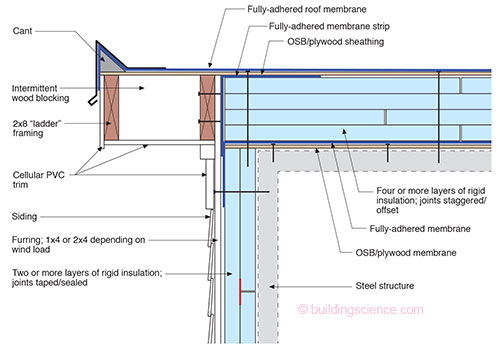
Figure 1: Roof-to-Wall Interface—The roof air control layer is the fully-adhered membrane on the lower layer of OSB/plywood. Note how it connects to the exterior face of the outermost layer of rigid insulation on the wall. The exterior face of the outermost layer of rigid insulation is the wall air control layer.
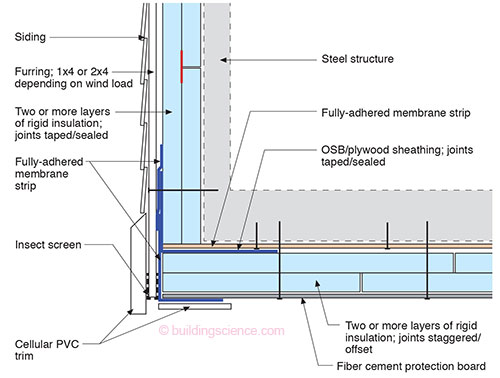
Figure 2: Wall-to-Floor Interface—The floor air control layer is the taped/sealed OSB/plywood installed directly on the underside of the structure. Note how it connects to the exterior face of the outermost layer of rigid insulation on the wall. The exterior face of the outermost layer of rigid insulation is the wall air control layer. Also note the “screened gap” at the bottom of the airspace behind the cladding. And finally note the protection board at the underside of the floor assembly protecting the insulation layers from insect and vermin attack.
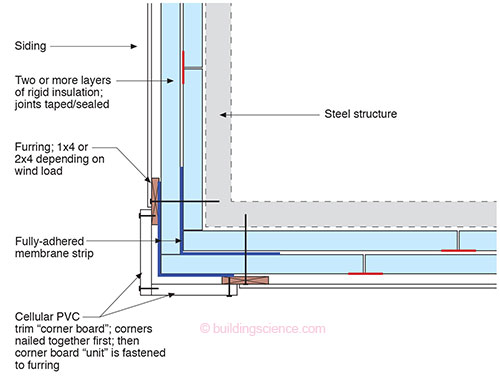
Figure 3: Exterior Corner—The cellular PVC trim “corner board” pieces are connected to each other first and then the “L-shaped” corner board “unit” is fastened to the furring.
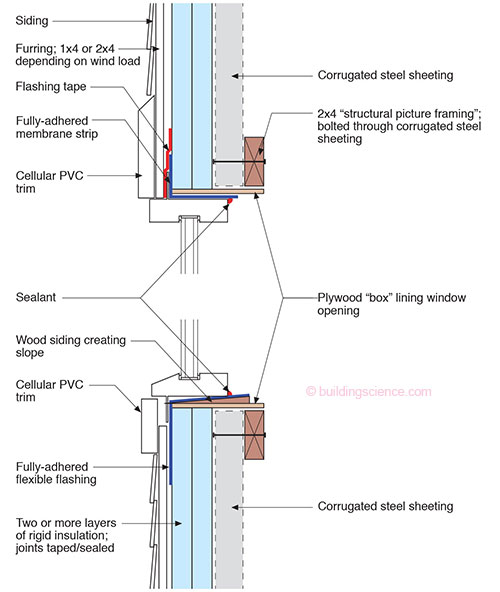
Figure 4: Punched Opening—The interior of the opening “punched” into the corrugated steel sheeting is “picture framed” with 2x4 framing to provide structural support for the plywood box lining the opening. The window is installed as an “outie” rather than an “innie” because the water control layer is the exterior face of the outermost layer of rigid insulation.
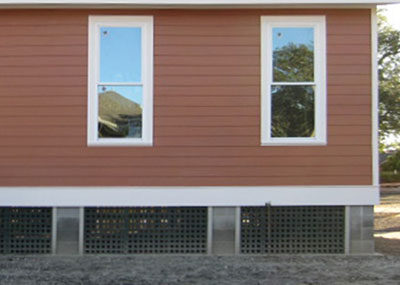
Photograph 4: Elevate the Structure—This works for mobile homes and for shipping containers. Lift them off the ground, insulate underneath them and screen the perimeter.
So why would anyone ever want to insulate on the inside? Well, if you insulate on the inside the existing “box” is both your cladding and your structure. You don’t have to “buy” and install a new separate cladding system. Just clean up the existing box (or not if you like rust and graffiti and shipping company logos…) and paint it9.
When you insulate on the inside the shipping container has to be watertight. Even when “brand new” these steel boxes are not completely waterproof. They are pretty darn good, but not perfect. When you insulate on the inside the existing box becomes a “face-sealed” system. The welds have to be perfect and continuous where the corrugated sheets connect to the box tube frames and where the corrugated sheets connect to each other. We have not historically had lots of positive experience with “face-sealed” systems. You can make face-sealed systems work but it is not easy. You have to be anal, fastidious, German-like, perfect. I think you get the message.
If you decide to go the interior insulation route for gosh sakes at least cover the top of the box with a new roofing membrane. And expect the walls to leak. Not a lot, but a little bit. So that means that your interior insulation had better not be water sensitive. This is the main reason that most internally insulated shipping container homes use high-density (2 lb/ft3) spray polyurethane foam (SPF). The other is that when you use at least 2 inches of SPF the vapor transmission of the SPF is less than 1 perm. You get a Class II vapor retarder which means you can use this approach everywhere – even in Tuktoyaktuk (Photograph 5 and Photograph 6).
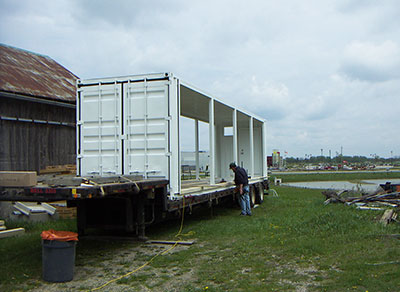
Photograph 5: Adaptive Reuse—The “building science research” version. This “test hut” was “anally” water and air sealed on the exterior and insulated on the interior with non water sensitive high-density (2 lb/ft3) spray polyurethane foam (SPF). Minimum of 2 inches of SPF yields a vapor transmission of less than 1 perm. You get a Class II vapor retarder, which means you can use this approach everywhere – even in Tuktoyaktuk.
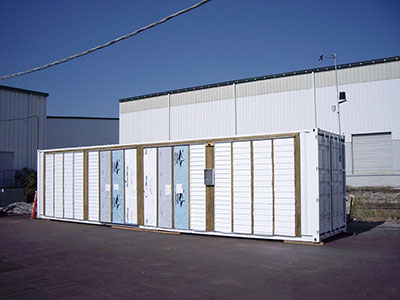
Photograph 6: Mobile Hygrothermal Test Bed—designed, constructed and instrumented by Building Science Consulting, Inc. out of Waterloo, Ontario.
And when you line the interior of the SPF with gypsum board it ought to be “paperless”. If paper faced gypsum board gets wet it grows stuff10. And for gosh sake no interior vapor barrier like vinyl wall coverings.
Personally, I think the risks of internally insulating are too high unless you are in a place that does not rain, like Las Vegas, but I have not been very successful at talking folks out of it. So when you don’t listen to me and do it on the inside at least do it the way I describe above to reduce your risk. So I want you to listen to me even when you don’t listen to me.
Footnotes
- See: http://historymyths.wordpress.com. They are still arguing about it in Nantucket. The legend goes that ballast in the form of cobblestones in empty whaling ships returning to their home port of Nantucket after having unloaded their cargos abroad was used to pave the streets. “Historymyths” makes the point that “all Yankee captains knew the value of their cargo space and seldom, if ever, made a voyage without a payload.” Apparently the cobblestones for the streets in Nantucket came from Gloucester, MA, but it makes a good story the other way around. And I love good stories, even if they are not true. I am a consultant after all.
- After the United States Navy and the Royal Navy. During “the Battle of the Atlantic the Royal Canadian Navy sank 31 U-boats and sank or captured 42 enemy ships, while successfully completing 25,000 merchant crossings. The Royal Canadian Navy lost 24 ships and 1,800 sailors in the war”. We Canadians, us older ones, get irritated when folks take a run at our navy. We don’t get mad, only irritated, because at the end of the day, we are after all Canadian.
- See: http://www.oldsaltblog.com/2014/02/building-new-york-with-ships-ballast-cobblestones-blitz-bricks-bristol-basin/. This is a good story and a true one. You will find a commemorative plaque if you look for it hard enough. East River Drive is now FDR Drive.
- Malcom McLean is considered the “father of containerization” and the company he founded is Sea-Land Service, Inc.
- When the first container ship sailed from Newark, NJ to Houston, TX in 1956 the head of the International Longshoreman’s Association was overheard to say: “I’d like to sink that son of a bitch”.
- “Canadian hockey players?”
- The economics of shipping empty shipping containers is not as bad as some folks make out. Shipping companies are not stupid. It costs $2K to $3K to make a new container. Shipping companies own most of the containers. The shipping containers can easily have a useful service life of 30 years or more. They are an “asset” and shipping companies go to a great deal of trouble to track them and reposition the empty ones. China manufactures most of the containers in use today. China also makes a lot of stuff that is then shipped inside the containers to all over the place. It makes sense to make the containers in the place where they are going to be first used. Duh. Most shipping companies are integrated – they own trucking and rail assets as well as port assets and have figured out how to have high utilization rates with containers. Not a lot of empty containers are moved around very far. These shipping companies typically reposition their containers efficiently. Not a lot of containers are piling up abandoned.
- A week does not go by without our office getting a call asking if we have a design to make energy efficient homes out of shipping containers. Our first comment is: “Do you really want to do this? What is wrong with a nice wood home?”
- I think the reason that so many shipping containers are insulated on the inside is that folks want other folks to know that a shipping container was used. I think a lot of folks want everyone to know just how “green” they are. What is the point of being green without being able to brag about it and rub everyone’s nose in it? Why do you think a Prius looks so ugly? Everyone needs to know it is a Prius so they know just how responsible you are… Me, I drive a Porsche because I am a middle-aged man with self-esteem issues. OK, truth be told, some of the shipping container houses look quite spectacular. Bravo to the architects that make them so. But to me most of them look pretty bad.
- Maybe that is why folks refer to this as a “green” technology?
